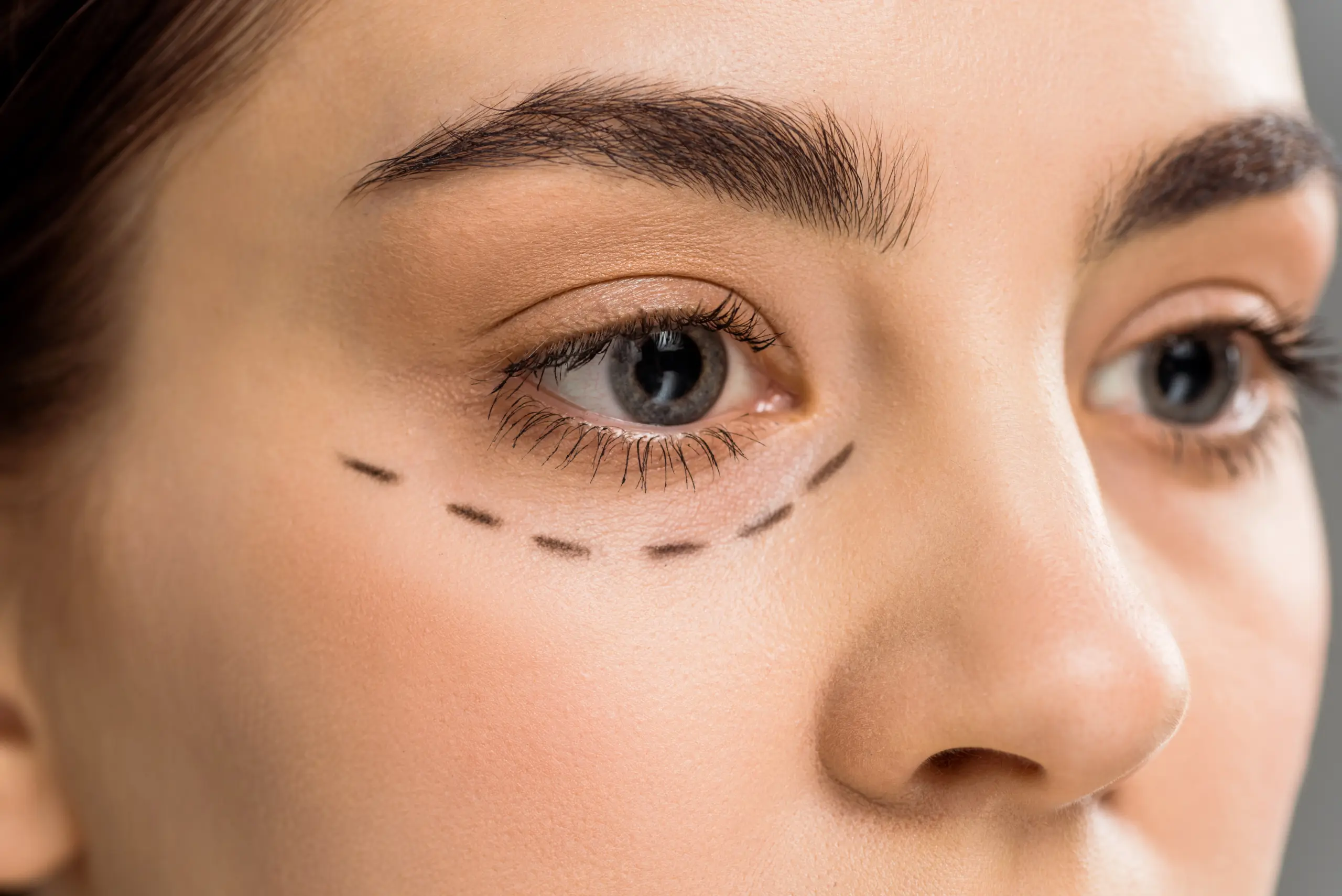The delicate eye area is often one of the first places to show signs of aging, from sagging lids to tired-looking eyes. A surgical eye lift offers a permanent solution by physically removing excess skin and fat, while a non-surgical approach uses injectables and energy-based treatments for temporary enhancement with minimal downtime.
In this guide, we’ll walk you through every aspect of surgical and non-surgical eye lift options, from procedure details to recovery expectations. Understanding this core difference, the scalpel versus the syringe, is key to choosing your path toward a more refreshed appearance.
Comparing Surgical vs Non Surgical Eye Lift
Both surgical and non-surgical eye lift options can rejuvenate the eyes, but they differ in technique, recovery, and how long results last. The table below highlights the key distinctions to help you choose the right approach for your goals.
| Feature | Surgical Eye Lift | Non-Surgical Eye Lift |
| Invasiveness | Uses small incisions | No incisions, minimal entry |
| Results | Long-lasting, dramatic | Subtle, temporary |
| Recovery | 1–2 weeks | 1–3 days |
| Downtime | Moderate | Minimal to none |
| Maintenance | No Maintenance needed | Regular touch-ups required |
Exploring Non Surgical Eyelift Options
For those not ready for an eye lift surgery or who have milder concerns, the realm of the non surgical eye lift offers a versatile toolkit. Each treatment has a specific purpose, and often they are combined for a more comprehensive effect.
Laser Skin Resurfacing
This works by removing the outer layers of damaged skin, promoting the growth of new, smoother skin with improved texture and reduced fine lines. It’s ideal for addressing sun damage and crepiness around the eyes, with results that can last for over a year.
Radiofrequency and Ultrasound Therapy
This method takes a different approach by delivering controlled energy deep beneath the skin’s surface. This heats the tissue, stimulating your body’s natural collagen production to create a gradual, subtle tightening and lifting effect over several months. It’s well-suited for those with mild skin laxity.
Dermal Fillers
Dermal Fillers are a master of illusion, expertly used to fill in the hollows under the eyes known as tear troughs. By restoring lost volume, they can dramatically reduce the shadowing that contributes to a tired appearance. It’s important to note that fillers add volume, they are not a solution for removing bulging fat pads.
Injections
While famous for smoothing wrinkles, it can also be used strategically for a subtle lift. When injected in specific points around the outer brow, it can relax the muscles that pull the brow downward, allowing the elevating muscles to lift the tail of the brow slightly, opening up the eye area.
Platelet-Rich Plasma (PRP)
Platelet-Rich Plasma (PRP), often called the “Vampire Facial” for the eyes, uses growth factors from your own blood to rejuvenate the skin. This natural treatment improves skin texture, tone, and can help with dark circles, offering a refreshed look with minimal risk and no downtime.
Thread Lifts
Thread Lifts provide a more significant lift than injectables alone. Temporary, dissolvable threads are placed under the skin to gently lift and support sagging tissues, while also stimulating long-term collagen production. This offers a middle ground for those seeking noticeable lifting without a full surgical procedure.
The Plasma Pen
The Plasma Pen is a non-surgical tool that uses a plasma arc to create tiny, controlled injuries on the skin’s surface. As the skin heals, it contracts and tightens, which can be used to address very fine lines and minor skin excess on the upper eyelid. It is not a solution for significant hooding caused by excess skin or fat.
When is surgical eye lift the better option?
While non-surgical treatments have their place, there are certain concerns that only surgery can effectively and permanently correct. Surgical eye lift becomes the unequivocally better option when you are dealing with significant, structural changes.
If you have a noticeable fold of skin on your upper eyelids that hides your natural crease or even begins to impair your vision, surgery is the only way to remove it. Similarly, if you have puffy, hereditary under-eye bags caused by protruding fat pads, surgery is the only way to precisely remove or reposition these fat pads for a smooth contour. For a closer look at different treatment options, see our guide on how to remove eye bags permanently.
How do you choose between surgical and non surgical eye lift?
Making the final choice between these two paths is a personal decision that hinges on a few key questions:
- First: honestly assess your primary concern. Is it fine lines, mild puffiness, and hollowness, or is it significant, draping skin and obvious eye bags? Your answer will point you strongly towards one category.
- Next: consider your lifestyle and tolerance for downtime. Can you accommodate a one-to-two-week recovery period, or do you need a solution with zero interruption?
- Finally: think about your budget perspective. Are you prepared for a one-time investment, or do you prefer smaller, ongoing payments for maintenance?
There is no one-size-fits-all answer, and the best plan is often recommended by an expert after a thorough consultation.
Frequently Asked Questions (FAQs)
No, it cannot. Non-surgical treatments can tighten skin mildly by stimulating collagen, but they are incapable of removing the significant, draping skin that requires a surgical blepharoplasty.
Plan for about 1-2 weeks of social downtime. You will experience swelling and bruising that peaks in the first few days and then gradually subsides. Most people feel comfortable returning to work and social activities after two weeks.
Yes, for mild skin laxity or early signs of ageing, non-surgical blepharoplasty can offer noticeable tightening and smoothing without downtime. However, results are temporary and subtle compared to surgical blepharoplasty, which delivers a more defined and long-lasting lift for moderate to severe eyelid sagging.
The best alternatives include plasma fibroblast therapy, radiofrequency skin tightening, or laser resurfacing, all of which improve eyelid firmness and texture without surgery. For brow-related hooding, brow lift is a good alternative to blepharoplasty, anti-wrinkle injections can also create a lifting effect.
Results typically last 6 to 18 months, depending on the treatment method, skin type, and aftercare. Regular maintenance sessions are usually needed to sustain results, whereas surgical blepharoplasty can last many years.
No. Blepharoplasty is considered a low-risk procedure when performed by an experienced surgeon. Common side effects include temporary swelling or bruising, while serious complications such as infection or asymmetry are rare. Most patients recover smoothly with excellent, lasting results.
Book a consultation with an expert eye lift surgeon
Understanding the differences is just the start. Your eyes are unique and deserve a personalized assessment. Our expert surgeons will evaluate your anatomy and goals to provide honest, clear guidance on the best path forward.
Let us help you achieve the refreshed, vibrant look you desire with a plan tailored just for you.






